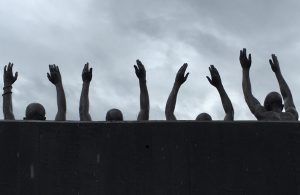Securing Our Past/Future – A Weekly Letter From Rabbi Davis – April 5, 2019
Shalom Chaverim,
The memorial and monuments we saw on Beth El’s recent civil rights trip were incredibly powerful. From the quiet water fountain outside the Southern Poverty Law Center to the heavy, dangling pillars of the lynching memorial, they left a lasting impression. Words can hardly convey the feeling.
I was expecting to be moved by the design, the setting, the symbolism, etc. of these places. One thing I was not expecting, however, was the security. There were concrete barriers around some of these monuments, metal detectors around others. Over and over, our tour guide told us to leave hand-bags on the bus; he let us know in advance to expect heavy security.
It is sad that these security measures are necessary. Their presence is a clear indication that hostility still exists to the ideas represented by these monuments. In fact, just this week, the institute that prepared Rosa Parks for the Montgomery bus boycott was torched by white supremacists. These security measures are also constant reminder of how groundbreaking these monuments are. And they helped me appreciate just what these monuments signify: they are a courageous attempt to reclaim history, to tell the truth about America’s past. It is a past some would prefer to hide.
In a previous Beth El trip to the south, we visited the plantation, Hobcaw Barony, in South Carolina. Restored with its original furniture, the house was beautiful. After touring the main grounds, we drove past the nearby slave quarters known as Friendfield Village. This cluster of six houses was tucked away in the woods- out of sight, out of mind. We have done the same with our nation’s history. Until now.
As Jews, we are the people of Zakhor, memory. We use rituals, foods, entire holidays to recall ancient days. We establish museums and memorials. We erect signs that retell our history, including our darkest hours.
Not so America. Buildings that once housed slave auctions were converted to warehouses or lofts. We erected monuments to Confederate leaders. We even turned plantations into wedding destinations. Can you imagine holding a wedding in a slave labor camp?!
 Now one year old, Montgomery’s so-called Lynching Memorial is America’s first, large-scale effort to memorialize slavery and lynching in the U.S.. But it is not simply about recalling the past. “For me,” writes Stanford history professor, James Campbell, “the true challenge of this work isn’t just altering the way society tells stories about its past, but also thereby changing the matrix of political possibility in the present. The work that the Equal Justice Initiative has done has not only been to create one of the most arresting and powerful memorials to America’s history of racial violence, but also to work in concrete ways in the present to redress the continuing legacies of that history.”
Now one year old, Montgomery’s so-called Lynching Memorial is America’s first, large-scale effort to memorialize slavery and lynching in the U.S.. But it is not simply about recalling the past. “For me,” writes Stanford history professor, James Campbell, “the true challenge of this work isn’t just altering the way society tells stories about its past, but also thereby changing the matrix of political possibility in the present. The work that the Equal Justice Initiative has done has not only been to create one of the most arresting and powerful memorials to America’s history of racial violence, but also to work in concrete ways in the present to redress the continuing legacies of that history.”
That is why the memorial is so threatening to some and why it requires tight security. By reclaiming the past, it seeks to bring equality and justice to the present. The words inscribed on the wall of the memorial speak to that dual mission:
For the hanged and beaten.
For the shot, drowned, and burned.
For the tortured, tormented and terrorized.
For those abandoned by the rule of law.
We will remember
With hope because hopelessness is the enemy of justice.
With courage because peace requires bravery.
With persistence because justice is a constant struggle.
With faith because we shall overcome.
Amen.
Rabbi Alexander Davis
adavis@bethelsynagogue.org
